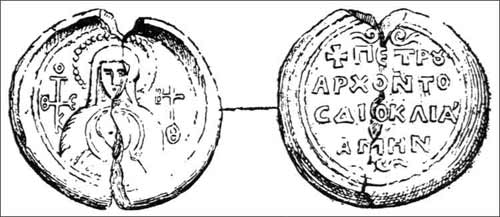Petar Of Duklja on:
[Wikipedia]
[Google]
[Amazon]
 Peter of Diokleia or Petar ( sr, Петaр/Petar) was an ''
Peter of Diokleia or Petar ( sr, Петaр/Petar) was an ''
p. 24
A list of mythological rulers of this time exist in the dubious
 Peter of Diokleia or Petar ( sr, Петaр/Petar) was an ''
Peter of Diokleia or Petar ( sr, Петaр/Petar) was an ''archon
''Archon'' ( gr, ἄρχων, árchōn, plural: ἄρχοντες, ''árchontes'') is a Greek word that means "ruler", frequently used as the title of a specific public office. It is the masculine present participle of the verb stem αρχ-, mean ...
'' of Duklja
Duklja ( sh-Cyrl, Дукља; el, Διόκλεια, Diokleia; la, Dioclea) was a medieval South Slavic state which roughly encompassed the territories of modern-day southeastern Montenegro, from the Bay of Kotor in the west to the Bojana Ri ...
in the 10th century. The only information on him is from a seal found in the 19th century, which is decorated on the observe with a bust of the Virgin Mary
Mary; arc, ܡܪܝܡ, translit=Mariam; ar, مريم, translit=Maryam; grc, Μαρία, translit=María; la, Maria; cop, Ⲙⲁⲣⲓⲁ, translit=Maria was a first-century Jewish woman of Nazareth, the wife of Joseph and the mother o ...
holding a medallion of Christ
Jesus, likely from he, יֵשׁוּעַ, translit=Yēšūaʿ, label=Hebrew/Aramaic ( AD 30 or 33), also referred to as Jesus Christ or Jesus of Nazareth (among other Names and titles of Jesus in the New Testament, names and titles), was ...
and flanked by two cruciform
Cruciform is a term for physical manifestations resembling a common cross or Christian cross. The label can be extended to architectural shapes, biology, art, and design.
Cruciform architectural plan
Christian churches are commonly described ...
invocative monograms. The text is in Greek letters
The Greek alphabet has been used to write the Greek language since the late 9th or early 8th century BCE. It is derived from the earlier Phoenician alphabet, and was the earliest known alphabetic script to have distinct letters for vowels as we ...
, saying ΠΕΤΡ �� ΑΡΧΟΝΤΟΣ ΔΙΟΚΛ ��Α �ΑΜΗΝ (''Petr , Archontos Diokl as, Amen''), i.e. " ealof Peter, archon of Duklja, Amen
Amen ( he, אָמֵן, ; grc, ἀμήν, ; syc, ܐܡܝܢ, ; ar, آمين, ) is an Abrahamic declaration of affirmation which is first found in the Hebrew Bible, and subsequently found in the New Testament. It is used in Jewish, Christian, and ...
". The seal shows that although Duklja underwent turmoil in the 9th century, the region still continued under Byzantine
The Byzantine Empire, also referred to as the Eastern Roman Empire or Byzantium, was the continuation of the Roman Empire primarily in its eastern provinces during Late Antiquity and the Middle Ages, when its capital city was Constantinopl ...
rule or at least cultural influence
Culture () is an umbrella term which encompasses the social behavior, institutions, and norms found in human societies, as well as the knowledge, beliefs, arts, laws, customs, capabilities, and habits of the individuals in these groups.Tylo ...
.
The stamp was kept in the Medal cabinet of Berlin
Berlin ( , ) is the capital and largest city of Germany by both area and population. Its 3.7 million inhabitants make it the European Union's most populous city, according to population within city limits. One of Germany's sixteen constitue ...
and before 1884 it was in a decayed condition. Illustration based on the original by ''Léon Dardel'', was first published in 1884 by Gustave Schlumberger
Léon Gustave Schlumberger (17 October 1844 – 9 May 1929) was a French historian and numismatist who specialised in the era of the crusades and the Byzantine Empire. His ' (1878–82) is still considered the principal work on the coinage of the c ...
.
The history of Duklja until the 10th century is little known.''The former Yugoslavia's diverse peoples: a reference sourcebook''p. 24
A list of mythological rulers of this time exist in the dubious
Chronicle of the Priest of Duklja
The ''Chronicle of the Priest of Dioclea or Duklja'' ( sh, Ljetopis popa Dukljanina) is the usual name given to a purportedly medieval chronicle written in the late 13th century by an anonymous priest from Duklja. Its oldest preserved copy is in La ...
compiled in the 13th century or even the 16th and 17th centuries. In this chronicle, the father of Prince Jovan Vladimir
Jovan Vladimir or John Vladimir ( sr-cyr, Јован Владимир; c. 990 – 22 May 1016) was the ruler of Duklja, the most powerful Serbian principality of the time, from around 1000 to 1016. He ruled during the protracted war between t ...
(ruled ca. 1000 – 1016) is named '' Petrislav'', possibly meaning that Peter and Petrislav are the same.Živković 2006, "Владимир". It is mentioned in the Chronicle of the Priest of Duklja
The ''Chronicle of the Priest of Dioclea or Duklja'' ( sh, Ljetopis popa Dukljanina) is the usual name given to a purportedly medieval chronicle written in the late 13th century by an anonymous priest from Duklja. Its oldest preserved copy is in La ...
that Petrislav is a descendant of the Trebinje Prince Hvalimir and was given Duklja to rule as part of Hvalimir's domain.
Notes
References
*McGeer, Eric (2005). ''Catalogue of Byzantine Seals at Dumbarton Oaks and in the Fogg Museum of Art: The East (continued), Constantinople and environs, unknown locations, addenda, uncertain readings''. Dumbarton Oaks. , . *Živković, Tibor (2006). ''Портрети српских владара (IX-XII)'' (in Serbian). Belgrade: Zavod za udžbenike. . 10th-century Serbian nobility 11th-century Serbian nobility Medieval Montenegro Rulers of Duklja {{Serbia-noble-stub